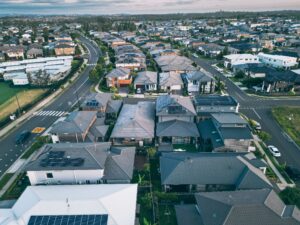The Bank-to-Miner Rotation: Is the ASX’s Great Shift Happening Now?

After an extraordinary 2024, when Australia’s major banks rose by more than 40 per cent, investors are beginning to wonder whether the next leg of the ASX rally will belong to the miners instead. The Big Four: Commonwealth Bank of Australia (ASX: CBA), Westpac (ASX: WBC), National Australia Bank (ASX: NAB) and ANZ Group (ASX: ANZ), delivered record dividends and share-price gains as rising interest margins and the Reserve Bank of Australia’s decision to pause further rate hikes fuelled optimism.
Yet markets rarely move in a straight line. When valuations stretch and growth plateaus, capital often migrates towards the next undervalued opportunity. This year, that opportunity could be found in ASX mining stocks. With iron ore holding around US$95–110 a tonne, copper and gold regaining momentum, and Beijing launching a fresh infrastructure stimulus, a clear sector rotation narrative is emerging, out of financials and into resources.
What are the Best ASX stocks to invest in right now?
Check our buy/sell tips

Valuations Tell a Story of Excess and Opportunity
Valuation differentials between banks and miners have reached levels unseen since the mid-2010s. According to Bloomberg, CBA trades on roughly 26× forward earnings, substantially higher than many US banking peers such as JPMorgan and Citigroup. The S&P/ASX 200 Banks Index has rallied nearly 38 per cent over the past year, while the S&P/ASX Resources Index is up only about 10 per cent. Investors are starting to ask how much upside remains. Loan growth is decelerating, deposit competition is squeezing net-interest margins, and operating expenses continue to rise as the banks spend heavily on technology and compliance.
In contrast, major miners like BHP (ASX: BHP) and Rio Tinto (ASX: RIO) are trading at more modest multiples, around 10–12× forward P/E ratios, with dividend yields often in the 5 per cent range (depending on commodity cycles). For investors seeking both income and capital growth, those valuations look increasingly appealing.
The ASX remains heavily bank-weighted; financials represent a large share (often estimated near 25–35 %) of the index, so even small reallocations towards miners can shift market dynamics. Institutional portfolio managers know this well: when one of the largest sectors becomes expensive, the rebalance into cyclicals can drive meaningful index-level rotation.
China Back in the Driver’s Seat
If the ASX’s next phase is to favour resources, China will be the engine. Beijing has recently discussed stimulus measures focused on infrastructure, housing, and clean energy, though the precise size and timing (for example, a package of A$190 b or US$125–130 b) remains speculative. The People’s Bank of China has previously cut the reserve-requirement ratio, injecting additional liquidity for banks to lend to construction and manufacturing.
That policy stance matters because China consumes a large share of global seaborne iron ore (estimates often near 60–70 %) and a major portion of copper. The World Bank projects Chinese GDP growth near 4.7 per cent in 2025, while OECD and other agencies forecast continued base-metal demand through 2026. A modest rebound in Chinese industrial activity would support Australian resource exports just when domestic credit growth is softening.
RBA Pause Fuels Risk Appetite
The Reserve Bank of Australia’s current cash rate is 3.60 per cent (as of its recent decision) after a cut in August 2025. This suggests that the tightening cycle is possibly over or at least on hold.
This has two implications. First, the prospect of future rate cuts reduces the relative appeal of bank dividends, which rely on robust interest margins. Second, a pause or softening rate environment encourages investors to look for cyclical growth elsewhere, particularly in mining stocks that benefit from lower financing costs and a relatively weaker Australian dollar (though the precise AUD/USD level fluctuates). A softer currency plus stable or easing rates often signals an opportunity for commodity exporters.
Commodity Prices Regaining Momentum
Commodities have quietly strengthened after volatile periods. Iron ore is trading near US$95–110 per tonne, copper around US$3.80–4.30 per pound, and coal prices have rebounded above US$100–130 per tonne, depending on type and quality. Gold is trading closer to US$2,200–2,400 per ounce, supported by central bank purchases and safe-haven demand.
Even lithium, which lagged in 2024, is showing signs of stabilisation as EV demand recovers and Chinese battery inventories decline. Because miners’ earnings are highly sensitive to commodity prices, even modest increases can drive disproportionately large gains in margins and free cash flow. For example, a 10 per cent rise in iron-ore prices could lead to 15–25 per cent growth in EBITDA for diversified majors under favourable cost conditions.
Earnings Season Highlights the Divergence
Recent earnings seasons have underlined the growing bifurcation. Commonwealth Bank’s FY2025 results showed record cash earnings of A$10.25 billion and a record dividend, marking ~4 % growth year over year. NAB flagged flat housing credit growth, and Westpac emphasised cost-control moves to defend margins.
By contrast, resource companies such as BHP reported strong free cash flow, Rio Tinto pushed ahead with capital investment (e.g. in Simandou), and gold producers like Newmont have reported robust output at certain operations. The divergence is increasingly visible: banks are navigating margin pressure, while miners are positioning for upside should commodity demand remain strong.
Institutional Flows and ETF Signals
Fund-flow data support the rotation narrative, though precise numbers vary across sources. Recent quarters have seen notable inflows into resource-oriented ETFs, while some financial-sector funds have recorded net outflows. Superannuation funds and international managers are also reportedly increasing allocations to commodities as inflation hedges.
Digital investment platforms (like HALO) and portfolio analytics show rising resource-sector weights from mid-2025. The pattern echoes past cycles (e.g. 2016) when investors repositioned from income stocks into cyclicals. If the trend persists, 2025 may see resources outperform financials in the ASX 200.
Income vs Growth: The Investor’s Dilemma
Australian investors have long leaned toward bank shares for their dependable, fully-franked dividends. Currently, the average grossed-up yield for the Big Four is estimated in the 5–6 per cent range, though this varies with earnings, balance-sheet strength, and payout policy.
By contrast, miners can offer both yield and growth optionality. For instance, BHP and Rio Tinto have historically offered solid dividend streams, and companies like Fortescue (ASX: FMG) claim multi-year high payout ratios (though exact consistency should be checked annually). A balanced portfolio might combine core bank holdings for income stability, plus selective exposure to mining equities for cyclical upside.
Risks to the Rotation
No theme is without risk. A sharper-than-expected slowdown in China’s real estate or industrial sectors could undercut demand for iron ore and base metals. A strong US dollar could also drag on commodity prices globally. Domestically, resilient housing credit, employment near 4 %, and consumer spending might sustain bank earnings longer than some expect.
Analysts note that bank returns on equity remain in healthy zones (for example, CBA has reported ROE ~13–14 %). Meanwhile, mining capital expenditure trends are increasing, exposing companies to cost inflation, project delays, and capital intensity risk. Thus, any rotation may be gradual rather than abrupt. Selectivity, balance-sheet strength, and capital discipline will matter greatly.
How Investors Can Position Themselves
Positioning for a bank-to-miner shift does not demand abandoning one sector entirely; it’s about strategic rebalancing. Investors can diversify within resources by combining exposure to iron-ore majors, gold producers, and critical-minerals names to mitigate commodity-specific volatility. Core holdings in banks can continue providing steady income and capital protection. Platforms such as Sharesight, HALO, and other analytics tools can help track sector exposure, dividend flows, and rotation momentum in real time.
Macro signals should guide timing: monitor China’s stimulus announcements, RBA meeting minutes, commodity inventory reports, and global rate trends. Together with valuation discipline and risk management, these indicators increase the odds of capturing rotation gains without chasing momentum blindly.
What If the Shift Accelerates?
If China’s stimulus translates into higher steel output while global monetary easing weakens the US dollar, Australia’s mining sector could enter a multi-year upcycle. That scenario would mirror earlier periods (e.g. 2016–2019), when resource shares significantly outpaced financials in total return.
In such a case, capital might move not just into majors but also into mid-cap and development-stage names such as Whitehaven Coal (ASX: WHC), Evolution Mining (ASX: EVN), and IGO Ltd (ASX: IGO). Upstream exploration names could also attract renewed investor interest.
However, if stimulus disappoints, inflation surprises force central banks to tighten, or commodity demand falters, the defensive traits of bank stocks, strong capital buffers, consistent dividends, and stable earnings, could regain favour. The goal is not prediction but a recognition of evolving macro expectations. Early monitors of rotation often benefit most.
The Bottom Line
The Australian market may now be entering a subtle transition. After years of dominant bank performance, valuations appear extended, and growth momentum is softening. Meanwhile, commodity strength, China re-engagement, and changing investor flows suggest resources are regaining investor attention. This shift doesn’t declare an end to the bank era; rather, it hints at a broader leadership base across the ASX. The most easily won gains in bank equities may already be behind us, while miners may be entering a more fertile phase. For investors attuned to cycles, rotation is not a threat; it’s an opportunity.
FAQs
- What is sector rotation on the ASX?
Sector rotation refers to the process of reallocating capital from sectors that have outperformed (e.g. banks in 2024) toward sectors likely to lead next (e.g. miners in 2025). It reflects the changing phases of economic growth, valuation, and investor sentiment.
- Why are ASX bank stocks considered expensive now?
CBA and its peers trade on forward earnings multiples (e.g. ~26× for CBA) that are high relative to historical norms and many global bank peers. Coupled with rising competition for deposits and weakening credit growth, the margin of safety narrows.
- What is driving interest in ASX mining stocks?
The appeal rests on rising commodity prices, promising Chinese demand stimulus, relatively lower valuations, and yield potential. Together, they draw institutional and retail capital back toward materials and resources.
- How does the RBA influence sector rotation?
When the RBA pauses or cuts rates, the AUD tends to weaken and borrowing costs fall — both positives for resource exporters. Meanwhile, the income yield from defensive sectors like banks becomes relatively less attractive.
- Should investors sell banks and buy miners now?
A balanced approach is wiser. Keep core bank positions for income and stability, while gradually increasing exposure to miners. Use leading macro signals, valuation discipline, and risk limits to guide sector shifts.
Blog Categories
Get Our Top 5 ASX Stocks for FY26
Recent Posts
Diversifying Portfolios with ASX Consumer Stocks: Opportunities and Risks
The ASX 200 has delivered significant volatility recently, and market participants observing the screens in 2025 understand the turbulence firsthand.…
Is Lendlease (ASX:LLC) out of the doldrums for good?
Lendlease (ASX:LLC) has for the past several years been the classic definition of a ‘value trap’. You think a good…
Here are the 2 most important stock market taxes that investors need to be aware on
As one of two certainties in life, investors need to be aware of stock market taxes. Investors may be liable…


